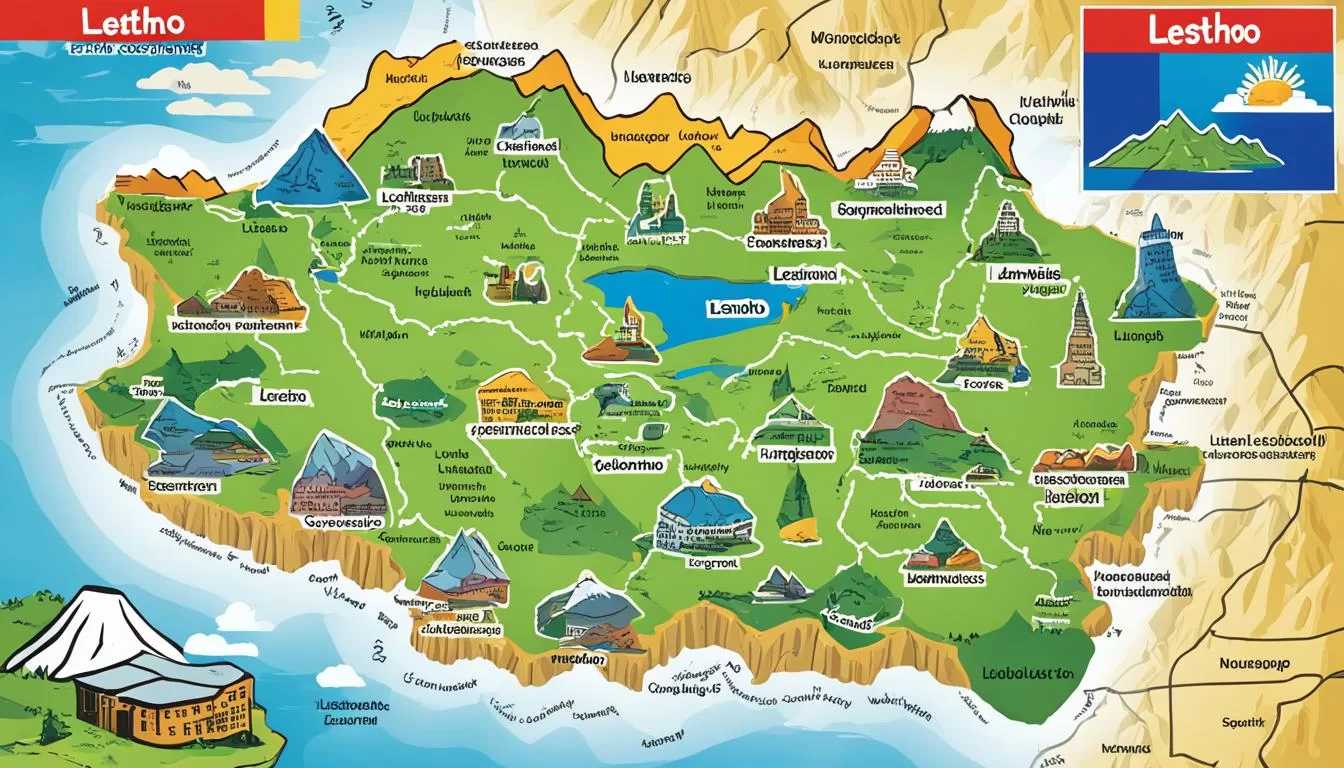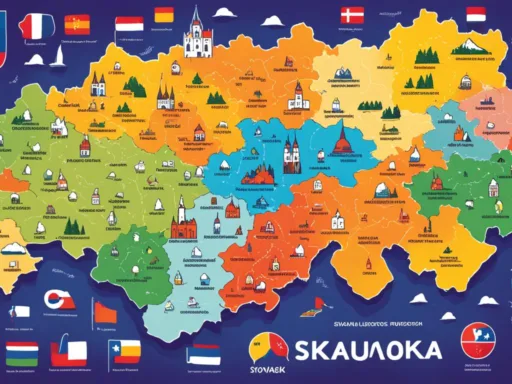Within the heart of Southern Africa lies Lesotho, a nation where the symphony of languages spoken creates a rich harmonic diversity. As globalization draws countries into a tighter network, Lesotho’s language diversity stands out, showcasing the enduring tapestry of its cultural heritage. Anchored firmly by Sesotho and English in Lesotho as the official languages, this small yet vibrant kingdom offers an inspiring glimpse into the essence of multiculturalism in Lesotho. From educational institutions to government corridors and the bustling marketplaces, the linguistic mosaic of Lesotho is an integral piece of its national identity.
Key Takeaways
- Sesotho and English solidify Lesotho’s commitment to a bilingual nation
- Lesotho’s unique blend of languages reflects its rich cultural tapestry
- The prevalence of Sesotho epitomizes the national spirit and identity
- English serves as a vital bridge in Lesotho’s official discourse and international relations
- Lesotho’s educational system fosters early immersion in its linguistic heritage
- A tribute to the nation’s multiculturalism is its recognition and preservation of minority languages
Linguistic Heritage of Lesotho: The Official and National Languages
The mountainous kingdom of Lesotho stands proudly with its rich linguistic heritage, which is deeply embedded into the fabric of everyday life. The national languages of Lesotho offer an invaluable insight into the resilience and cultural autonomy of a nation that has navigated colonial influence to preserve its unique identity. This linguistic landscape is anchored by the widespread use of Sesotho, also known as the Basotho language, and English in Lesotho, prominent within official domains and education.

Understanding Sesotho: The National Tongue
As the heartbeat of Lesotho’s linguistic identity, Sesotho resonates with over 90% of the population. Rooted in the country’s cultural practices, Sesotho manifests as both a unifying social force and a beacon of national pride. It stands testament to the linguistic heritage of Lesotho, playing an instrumental role across various spheres of daily interaction, from local commerce to traditional ceremonies.
English in Lesotho: A Tool for Official Discourse and Education
English emerges as the official partner in Lesotho’s quest for progress and connectivity with the global community. Serving as an indispensable tool for governance and international communication, English in Lesotho underscores the country’s dedication to engaging on a broader stage, interwoven tightly within its educational language policy in Lesotho. With a gradual introduction from primary education onwards, English paves the way for the youth of Lesotho to tap into global knowledge networks and create opportunities for social mobility and economic growth.
The Historical Development of Lesotho’s Bilingual Policy
The inception of the Lesotho bilingual policy traces back to the significant year of the nation’s independence in 1966, when both Sesotho and English were enshrined as the official languages of Lesotho. The affirmation of this policy within Lesotho’s Constitution on languages, shaped in 1993, was a defining moment, legislating the mutual respect and equilibrium between the languages in all official and legal contexts. This visionary move charted a course for a country that values the potency of language as a cornerstone of self-expression and democracy.
In examining the historical context, the decision to favor bilingualism illustrates Lesotho’s commitment to maintain its esteem for ancestral roots while welcoming the practical advantages of a universally spoken language. Such foresight has laid a strong foundation for the Lesotho of tomorrow, nurturing linguistic dexterity that is anticipated to continue enriching the country’s sociocultural tapestry.
Languages Spoken Lesotho: A Dive into the Multicultural Linguistic Landscape
The kingdom of Lesotho, a small enclave nation within South Africa, is a marvel for language enthusiasts around the world. With its Lesotho language diversity on full display, the country presents a multicultural linguistic tapestry underscored by the prevalent indigenous languages in Lesotho. The foothills and highlands echo with the sounds of several Lesotho dialects, reminiscent of the historical exchanges and migrations that have shaped this nation.

At the core of this linguistic quilt lies a weaving of Niger-Congo languages—Sesotho sparkling as the gemstone. This beautiful language is not only the national and official language but also a symbol of unity amongst the Basotho people. Alongside, English stands as a co-official language, demonstrating the global outlook of Lesotho while maintaining its robust linguistic roots. However, the story does not end here.
Other subsidiary tongues bring vibrancy to the country’s colloquial speech. One can hear the rhythmic intonations of Isizulu, the poetic cadence of Siphuthi, and the melodic lilt of Isixhosa—languages that reflect the diverse ethnic threads interwoven through the fabric of the community. These voices, though minority, stand as a testament to the nation’s cultural plurality.
- Isizulu: Rich in tones, the Zulu language resonates with historical significance, spoken by communities in the southern and western parts of Lesotho.
- Siphuthi: A lesser-known but equally important idiom, offering a glimpse into the intriguing language dynamics at play within this geographic enclave.
- Isixhosa: With its distinctive click consonants, it is a testament to the cross-border linguistic exchanges that enrich Lesotho’s societal fabric.
The linguistic mosaic of Lesotho would be incomplete without mention of its immigrant languages. Among them, Afrikaans emerges with modest representation, drawing from the historical influences and its wider usage in neighboring South Africa.
Here in Lesotho, every language and dialect, whether of native or migrant origins, contributes to a greater narrative, painting the legacy of a nation steadfastly intertwined with its language diversity, resilient cultures, and enduring communal identities.
The Influence of Ethnic Groups on Lesotho’s Language Diversity
Intricately woven into the fabric of Lesotho’s society is a palette of languages, each bearing the marks of its ethnic origins and the stories of communities that have transcended geographic frontiers. In a landscape where the majority speaks Sesotho, the presence of other languages signifies the historical and cultural exchanges that have long defined this region.
Zulu and Xhosa: Languages Crossing Borders into Lesotho
The cultural exchanges of neighboring South Africa have left their linguistic imprint on Lesotho, with Zulu and Xhosa standing as significant examples of languages crossing borders. Zulu, with its rich oral tradition and resonant tones, is spoken by a considerable minority in Lesotho. Likewise, Xhosa, distinguished by its click consonants, marks the rhythmic diversity of Lesotho’s multicultural dialogue.
- Zulu reverberates within the homes and communities of over 248,000 Basotho.
- Xhosa, with around 18,000 speakers, enriches the linguistic heritage with its unique phonetics.

Phuthi: Preserving an Endangered Language within Lesotho’s Borders
Amid the dominant Sesotho and imported English, the Phuthi language remains a rare linguistic gem. Preserving endangered languages like Phuthi is vital to upholding the intangible cultural heritage of Lesotho. This language, with its distinct relationship to Swazi and deeply rooted historical connections to the Nguni people, struggles in the face of a prevailing Sesotho-English bilingual norm.
| Language | Speakers in Lesotho | Cultural Significance | Preservation Efforts |
|---|---|---|---|
| Zulu | 248,000 | Represents historical migration and cultural integration | Recognized within community practices |
| Xhosa | 18,000 | Symbolizes cross-border linguistic influence | Inclusion in cultural celebrations |
| Phuthi | 43,000 | Embodying the unique voice of the Nguni heritage | Endangered status necessitates active revitalization strategies |
The narrative of Lesotho dialects is not simply a matter of communication—it is a reflection of the perseverance of identities, often on the brink of fading into silence. Through intentional preservation and everyday use, the Phuthi language continues to contribute to the intricate mosaic of Lesotho’s identity.
Educational Language Policy in Lesotho: Sesotho and English
The dual pillars of primary education in Lesotho rest solidly on two languages: Sesotho and English. These serve not only as mediums of instruction but also as vital conduits for cultural immersion and global engagement. The educational policy in Lesotho reflects its dedication to fostering language competence and literacy in these languages among its citizens right from their early years.
Primary Education: Laying the Foundation in Sesotho
The journey of learning in Lesotho begins with Sesotho, the Sesotho medium of instruction that resonates deeply with the local culture and community ties. The first four years of schooling imbue children with a strong grasp of Sesotho, setting a robust foundation in their mother tongue, which is crucial for their cognitive and cultural development.
Leveraging the Sesotho language, educators in Lesotho aim to establish a connection with the young minds, ensuring that the roots of their heritage remain firm as they step forward into an increasingly interconnected world.
Secondary Education and Beyond: The Role of English
As students progress beyond the primary level, the educational focus shifts, integrating English as instructional language. From the fifth year of primary school onwards, English becomes the primary medium through which the curriculum is taught, especially in secondary education in Lesotho. This strategic linguistic transition is key to preparing the youth for broader academic and vocational opportunities, both within Lesotho and on the global stage.
The proficiency in English acquired during these formative years is an important stepping stone that enables young Basotho to engage in higher education, pursue professional careers and communicate effectively in a world where English often operates as the lingua franca of business and diplomacy.
Adult Literacy and Language Competence in Lesotho’s Population
Despite marked advancements in education, adult literacy in Lesotho presents a nuanced picture. A significant portion of the adult population is proficient in Sesotho, yet there remains a gap when it comes to English literacy. This indicates the ongoing need to bolster educational outreach and resources to ensure that adults are not only literate but also possess the language competence to thrive in diverse environments.
As Lesotho continues to nurture its human capital, the equilibrium between Sesotho and English literacy is viewed as pivotal for cultural preservation and socioeconomic progression, underscoring the importance of inclusive and comprehensive language education policies.

The commitment to linguistic duality within education serves as a reflection of Lesotho’s broader societal values—values that honor heritage while simultaneously looking outward to the future. Lesotho’s language policy within the realm of education is indeed a delicate balance, preserved and promulgated with the intent to carve pathways for the youth, adults, and ultimately, the nation’s success.
Conclusion
As we have journeyed through the linguistic landscape of Lesotho, we’ve uncovered a society rich in expression and steeped in heritage. The languages spoken Lesotho paint a vivid picture of a nation where the tapestry of voices – from the dominance of Sesotho to the official engravings of English – are harmoniously interlaced. The language policy of this vibrant kingdom reflects a profound respect for cultural identity and manifests in the fostering of a bilingual base which supports the complex societies of Lesotho.
Yet, the depths of Lesotho’s linguistic treasure trove extend beyond the bifold pillars of Sesotho and English. Minority and immigrant languages, part of the core that makes up the country’s cultural identity, continue to add texture and richness to the dialogue of daily life. As these languages contribute their distinct melodies to the chorus of communication, they too call for safeguarding and celebration.
It is evident that in supporting the language policy that advocates for diversity in speech, Lesotho champions the broader values of inclusivity and historical awareness. The educational sector, pivotal in nurturing future generations, remains a critical zone where language serves as the tool through which the world is understood and engaged. Addressing educational challenges and bolstering efforts to preserve minority languages will be critical as Lesotho advances, ensuring that every voice contributes to the symphony of this nation’s story. Anchored in its ancestral roots yet ever-evolving, Lesotho’s societal fabric remains a study in linguistic resilience and unity, upholding its revered place within the African continent and beyond.
FAQ
What Languages are Spoken in Lesotho?
The primary languages spoken in Lesotho are Sesotho and English, the official languages of the country. Additionally, there are minority languages present, including Zulu, Xhosa, and Phuthi, contributing to Lesotho’s multicultural linguistic landscape.
What Role Does Sesotho Play in Lesotho?
Sesotho is the national language of Lesotho and is spoken by over 90% of the population. It’s a central component of the Basotho people’s cultural identity and is used extensively in everyday communication, politics, religion, and media.
How Pervasive is English in Lesotho?
English in Lesotho is predominantly used for official purposes, government, and administration. It also serves as the language of instruction from the fifth year of primary education onwards, which emphasizes its importance for academic and professional opportunities.
Can You Explain Lesotho’s Bilingual Policy?
Lesotho’s bilingual policy, legally established in 1966 and embedded in the 1993 Constitution, recognizes both Sesotho and English as official languages. This policy promotes bilingualism and ensures that linguistic diversity is respected in legal and official matters.
Are There Indigenous Languages in Lesotho Besides Sesotho?
Yes, besides Sesotho, there are indigenous languages and dialects part of the Niger-Congo language family, such as Zulu, Xhosa, and Phuthi. These languages represent the diverse ethnic groups within Lesotho.
What is the Significance of Zulu and Xhosa in Lesotho?
Although minority languages, Zulu and Xhosa hold significance in Lesotho’s language diversity as they are spoken by certain segments of the population. Their presence reflects the linguistic influence of neighboring South Africa.
What Efforts are Being Made to Preserve the Phuthi Language?
Phuthi, an endangered language, has a relatively small but important presence in Lesotho. Efforts to preserve Phuthi include initiatives to encourage its use and the documentation of its linguistic features as part of cultural heritage.
How is Language Integrated into Lesotho’s Educational System?
Sesotho is the medium of instruction in primary schools up to the fourth year, reinforcing its foundational role in the nation’s culture. English takes over as the medium of instruction from the fifth year onwards to prepare students for the global socio-economic environment.
What Challenges Does Lesotho Face with Adult Literacy and Language Competence?
Despite the focus on bilingual education, a notable number of Basotho adults remain literate only in Sesotho, underscoring the challenge of enhancing bilingual language competence among the adult population in Lesotho.






